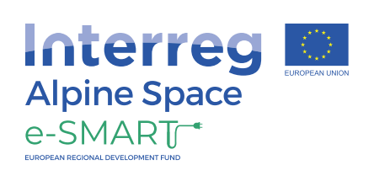e-SMART
|
Naziv projekta |
e-mobility SMART grid for passengers and last mile freight transports in the Alpine space |
|
Akronim |
e-SMART |
|
Št. pogodbe |
|
|
Program |
INTERREG Alpine Space The e-SMART project is co-financed by the European Regional Development Fund through the Interreg Alpine Space Programme. The total project budget amounts to € 2.53 million; application for ERDF funding amounts to € 2.15 million.
|
|
Trajanje |
October 2019 - March 2022 |
|
Status projekta |
Finished |
|
Partnerji |
RSE S.p.A. Regione Piemonte Veneto Strade S.p.A. The smart city association Italy BSC, poslovno podporni center, d.o.o., Kranj Pôle Véhicule du Futur Auvergne-Rhône-Alpes Énergie Environnement Hochschule Kempten Klima-Bundnis der europaischen Stadte mit iridigenen Volkern der RegenWalder SWW Sozial-Wirtschafts-Werk des Landkreises Oberallgau Wohnungsbau GmbH Landkreis München Magistrat der Landeshauptstadt Klagenfurt Codognotto Austria GmbH Stadtwerke Klagenfurt AG/Energie Klagenfurt GmbH Italienische Handelskammer Munchern-Stuttgart |
|
Namen projekta |
Project aims to contribute to a larger diffusion of e-mobility in the AS, thanks to cooperation of regional and local authorities with the private sector, by designing and testing an operational model to plan E-CS (Electric Charging Stations) in the framework of smart grid, smart territories and e-mobility services in passengers and freight transports (Local Public Transport and City/Last-Mile Freight Logistics). This model will enable PA’s policy makers and technicians to analyse and assess the energy grid needs related to e-mobility and, together with private operators, to plan E-CS networks and to support the growth of e-mobility options and services in transport sectors, increasing accessibility of peripheral and urban areas of the AS. |
|
Rezultati projekta |
e-SMART will foster the cooperation between private and public sectors to increase e-mobility passengers and freights transport options for the accessibility of metropolitan and peripheral area of AS. It foresees: 1) Increased common methods and approaches to plan e-mobility services; 2) Increased accessibility to e-mobility transport services for peripheral and metropolitan area of the AS. 3) Increased AS PAs’ skills and capacities to understand and assess the energy impacts and costs of e-mobility applied to LPT and LML. |
|
Spletna stran |

